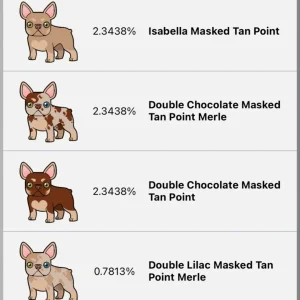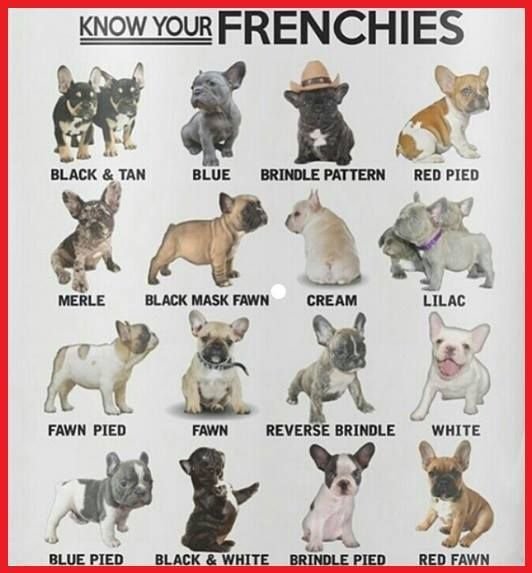When it comes to French Bulldog puppies, one of the most exciting questions for prospective owners is what color their adorable little furballs will be. French Bulldogs are known for their variety of coat colors and patterns, making each puppy truly unique. It’s fascinating to explore the genetics behind their coloration and unravel the mystery of what hues will be present in their offspring.
French Bulldog puppies can come in a wide range of colors, including brindle, fawn, pied, cream, and various shades of gray and black. The genetics behind coat color inheritance in French Bulldogs is complex, involving different genes and modifiers. For example, the presence of the K gene determines whether a French Bulldog will have a solid coat or be brindled. Understanding the genetic background and studying the lineage of the parents can provide insights into the potential color outcomes for the adorable French Bulldog puppies.
French Bulldog puppies can come in a variety of colors, including fawn, brindle, pied, and blue. The exact color of your puppies will depend on the colors of their parents and their genetic makeup. It is important to note that the color of the puppy can change as they grow older. To get a better idea of what color your French Bulldog puppies may be, it is best to check the colors of their parents and consult with a professional breeder.

The Colorful World of French Bulldog Puppies
French Bulldogs are known for their adorable appearance and unique personality. One question that many prospective owners have is, “What color will my French Bulldog puppies be?” The answer to this question is not as straightforward as you might think. French Bulldogs can come in a variety of colors and patterns, each with its own set of genetic factors. In this article, we will explore the different colors of French Bulldog puppies and how they are determined.
Understanding the Basic Coat Colors
French Bulldogs have a range of basic coat colors, which include fawn, brindle, and pied. These colors can be further categorized based on the genes involved in their expression. While fawn is the most common color, brindle and pied patterns add complexity and variation to the appearance of French Bulldogs. Let’s take a closer look at each of these coat colors.
Fawn
Fawn is the most common color in French Bulldogs. It ranges from a light tan to a deeper reddish-brown shade. The coat is typically uniform in color, although some fawn French Bulldogs may have a few white markings on their chest or other areas of the body. The fawn color is determined by the presence of the Ay gene.
Brindle
Brindle French Bulldogs have a base color that is streaked or striped with darker shades of black or brown. The stripes can be thin or thick, giving each dog a unique and distinctive pattern. The brindle pattern is caused by the K gene, which determines the distribution of black or brown pigment in the coat. Brindle French Bulldogs can also have fawn or pied markings, adding to their individuality.
Pied
Pied French Bulldogs are characterized by a white base coat with patches of another color. The patches can be any of the accepted French Bulldog colors, such as fawn or brindle. The pied pattern is caused by the presence of the S gene, which inhibits the production of pigment in certain areas of the coat. The result is a striking combination of white and another color, often creating a “patchwork” effect.
Factors Affecting Color Variation
Now that we understand the basic coat colors of French Bulldogs, it’s important to know that the actual color of a puppy is influenced by various factors. These factors can include the genetics of the parents, the presence of specific genes, and the interaction between these genes. Let’s explore the factors that contribute to color variation in French Bulldog puppies.
Genetics of the Parents
The coat color of a French Bulldog puppy is determined by the combination of genes inherited from its parents. Each parent contributes one gene for each color trait, such as fawn or brindle. The combination of these genes can result in a wide range of color variations in the offspring. For example, if both parents carry the brindle gene, there is a higher chance that the puppies will have brindle coats.
Inheritance of Specific Genes
Specific genes, such as Ay, K, and S, play a crucial role in determining the coat color of French Bulldog puppies. These genes can be passed down from the parents, leading to variations in color and pattern. The presence or absence of these genes can also influence the expression of other coat colors. Understanding the inheritance patterns of these genes can help predict the color possibilities in a litter of French Bulldog puppies.
Predicting the Color of French Bulldog Puppies
While it’s not possible to predict the exact color of a French Bulldog puppy with 100% certainty, understanding the color genetics can provide some insights. By knowing the coat colors of the parents and their genetic makeup, breeders and owners can make educated guesses about the potential color outcomes. However, it’s important to remember that genetics can be complex, and there is always a chance for unexpected color variations to occur.
The Colorful World of French Bulldog Puppies
To summarize, French Bulldogs can come in a variety of colors, including fawn, brindle, and pied. These colors are determined by specific genes and their interaction. The coat color of a French Bulldog puppy is influenced by the genetics of the parents and the inheritance of specific genes. While it’s not possible to predict the exact color of a puppy, understanding the basic coat colors and their genetic factors can provide some insights. If you’re considering getting a French Bulldog puppy, be prepared for the joy of welcoming a furry friend with their own unique coat color and pattern.
Key Takeaways: What Color Will My French Bulldog Puppies Be?
- French Bulldog puppies can come in a variety of colors including fawn, brindle, pied, and various shades of blue.
- The color of a French Bulldog puppy is determined by its parent’s genes, specifically the combination of their dominant and recessive genes.
- If both parents carry the recessive blue gene, there is a chance the puppies will be born with a blue coat.
- It is important to research the color genetics of the parents before breeding to have an idea of what colors the puppies may inherit.
- While the color of a French Bulldog puppy is exciting, it is important to focus on their health, temperament, and overall well-being.
Frequently Asked Questions
In this section, we will answer some frequently asked questions about the colors of French Bulldog puppies.
1. What are the possible colors of French Bulldog puppies?
French Bulldog puppies can come in a variety of colors. The common color variations include fawn, brindle, pied, and solid black. Fawn is a light tan color with a hint of red or yellow. Brindle is a pattern of dark stripes on a lighter background. Pied refers to a predominantly white coat with patches of another color.
It’s important to note that French Bulldog puppies can also have different markings on their coat. Some may have a mask or a black muzzle, while others may have white markings on their chest or paws. The exact color and markings of a French Bulldog puppy will depend on the genetics of its parents.
2. Can the color of French Bulldog puppies change as they grow?
Yes, the color of French Bulldog puppies can change as they grow. This is known as “puppy coat fade.” Some puppies may be born with a certain color, but as they get older, their coat may lighten or darken. This can happen due to various factors, including genetics and the presence of certain genes.
It’s important to consult with a reputable breeder who has knowledge of the parents’ coat colors and genetics. They can provide insight into the potential changes in color that a French Bulldog puppy may experience as it grows.
3. Are there any color restrictions for French Bulldog puppies in breed standards?
Yes, there are color restrictions for French Bulldog puppies in breed standards. According to the official breed standards, solid black, liver, black and tan, mouse, and white with black are not considered acceptable colors for French Bulldogs. These standards are set to preserve the breed’s characteristics and maintain a healthy gene pool.
It’s important to note that while certain colors may not meet breed standards, they can still be wonderful pets with loving personalities. The most important factor is the health and well-being of the French Bulldog puppy, regardless of its color.
4. How do I determine the color of my French Bulldog puppy?
Determining the color of a French Bulldog puppy can be done through several methods. The first is to observe the color of the puppy’s coat when it is born. Keep in mind that the color can change as the puppy grows.
Additionally, consulting with a reputable breeder who has knowledge of the parents’ coat colors and genetics can provide valuable insights. They can help determine the potential color and coat variations that the puppy may develop as it matures.
5. Can I choose the color of my French Bulldog puppy?
While you may have a preference for a certain color, it’s important to prioritize the health and well-being of the French Bulldog puppy rather than solely focusing on its color. Choose a reputable breeder who prioritizes the health, temperament, and overall quality of their puppies.
Remember that the color of a French Bulldog puppy can change as it grows, and what matters most is providing a loving and caring home for your new furry friend.

Standard and Exotic French Bulldog Colors Explained + PRICE BREAKDOWN
When it comes to predicting the color of French Bulldog puppies, there are a few important factors to consider. The color of the parents is the primary determiner, as certain colors are more dominant than others. If both parents have the same color, the puppies are likely to inherit that color.
However, if the parents have different colors, the puppies can inherit a combination of those colors or display a color pattern known as “brindle.” The possibilities include variations of fawn, cream, brindle, black, and blue. It’s important to note that the color of French Bulldog puppies can sometimes change as they grow older, so their final color may not be apparent until they are a few months old.
